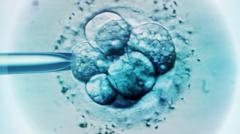In a historic moment for reproductive technology, Lindsey and Tim Pierce from Ohio celebrated the birth of their son, Thaddeus Daniel Pierce, from an embryo that had been frozen for over three decades. This remarkable event reportedly sets a new world record, surpassing the previous record held by twins born in 2022 from embryos frozen in 1992.
When Lindsey, 35, and Tim, 34, first learned of their successful pregnancy, Ms. Pierce described the experience as surreal, likening it to a scene from a science fiction movie. The newly born Thaddeus is now recognized as the longest-frozen embryo that successfully led to a live birth, illustrating substantial advancements in reproductive technology.
The journey to parenthood for the Pierces was a seven-year-long endeavor that culminated in their decision to adopt an embryo created by Linda Archerd, 62, in 1994 through in vitro fertilization (IVF). Initially, Ms. Archerd had four embryos; one of them has grown into her now 30-year-old daughter. After separating from her husband, Archerd made the deliberate choice to retain the remaining embryos rather than dispose of them, donate for research, or anonymously give them to other families.
In her desire for her embryos to remain with a family who shares similar values, Ms. Archerd partnered with Nightlight Christian Adoptions, a Christian embryo adoption agency, to find a suitable match. According to her preferences, she sought a married Caucasian couple practicing Christianity in the U.S. This led to her eventual connection with the Pierces.
The couple underwent the embryo transfer procedure at Rejoice Fertility, a clinic in Tennessee known for its mission to facilitate the transfer of embryos irrespective of their age. While the Pierces did not intend to achieve a record-breaking milestone, their primary goal was simply to start a family.
Though Ms. Archerd has not yet met baby Thaddeus, she mentioned recognizing resemblances between him and her daughter, highlighting the emotional ties and complexities surrounding embryo adoption.
As discussions about reproductive technology evolve, the story raises questions around the ethics of embryo storage, adoption, and the implications of assisted reproductive techniques on family dynamics. It captures the essence of hope and resilience in the pursuit of parenthood amidst the intricate landscape of modern science and personal values.




















